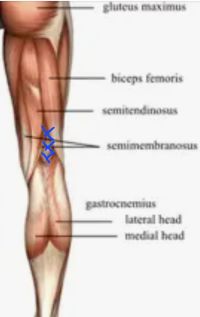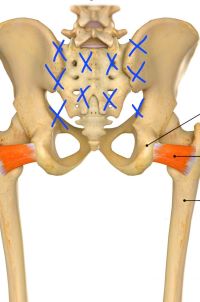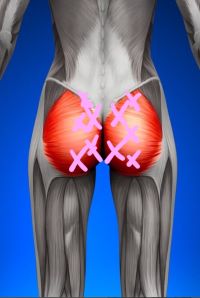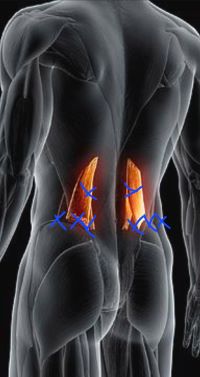Please review the instructions for Ball Work under the Self-Care Techniques page before proceeding.
Sciatica-related points for Static Pressure Technique with or without added movement.
When it comes to many hip/knee/ankle imbalances, some points need more attention on one side than the other. However, it is better to check both sides of the body than to only treat the side of discomfort. I will give you my general recommendations on each of the points below, but I highly recommend you check both right and left legs.
I have designed this page to initially do in the order you see here. Once you have mapped out where your restricted areas are, you can spend more time where you like. Return to checking them in this order to make sure you are not missing something and to keep everything in balance. I have observed that most of my patients get sciatica from a previous injury or condition of the ankle, knee, hip or low back. It is important to check all of the points below to promote a balanced pelvic girdle.
IT Band
.jpg)
Position - lying on your side, on the side that you want to treat
Where - on the floor or in bed for less pressure
Indications - perform on leg with sciatica symptoms, but do opposite leg as well to help balance pelvic stability.
Ball can be placed anywhere on the IT Band. However, I find the most restrictions are at the knee, as indicated, or where the gluteus maximus comes into the IT Band (just below the top arrow in this pic). Once you've done these two point you can explore any restrictions in between. You can also use a foam roller instead of a ball in this case if you wish to have broader pressure. No rolling!
*Added Movement for Fascial Restrictions - bend and straighten knee, OR ankle movement by pointing toes up and down or ankle circles
Sits Bone/Ischial Tuberosity
.jpg)
Position - sitting
Where - on a chair. A wooden chair provides the most pressure, but I've even done this on my office chair.
Indications - both legs regardless of symptomatic side
Locate your "sits bone", the bony area under your bottom that you feel when sitting upright in a chair. The ball should go directly in front of the sits bone. This will be your hamstring attachment. You could put it directly on the sits bone depending on the size of the ball (smaller and squishier works best), but if the ball is too hard you might create some bruising or it may be too difficult to relax. Do only one side at a time so your brain can absorb the information you are giving it.
*Added Movement for Fascial Restrictions - bend and straighten knee, OR swing foot left and right with bent knee to rotate at the hip, OR ankle movement by pointing toes up and down or ankle circles. Option to bend and straighten knee with any ankle movement.
Lower Hamstring

.jpg)
Position - sitting
Where - on a wooden chair for more pressure, non-wooden chair for less pressure
Indications - perform on the leg with sciatica symptoms. This is a possible site of impingement for the sciatic nerve, but do opposite leg as well to help balance pelvic stability.
While seated, place the ball in the middle of your posterior lower thigh, above the knee and between your hamstrings. This can be very sensitive if the fascia is adhered and the sciatic nerve is irritated. Be gentle, be patient, take deep breaths and remember to not do more than 2 minutes per point.
*Added Movement for Fascial Restrictions - bend and straighten knee, OR swing foot left and right with bent knee to rotate at the hip, OR any ankle movement. Option to bend and straighten knee with any ankle movement.
Deep Hip Rotators
.jpg)
Position - sitting
Where - on a chair, or seated on the floor with one or both legs out straight in front of you. Everyone's glute tissue is a little different, so try all of the seated positions and see which one works best for you.
Indications - leg with sciatica primarily, check other leg. This is a possible site of sciatic nerve impingement.
Now that you've identified your sits bone, you're going to move the ball just to the outside of it, towards the head of your femur. There is about a 1-3 inch space between your sits bone and femur head. That is where you want the ball to be situated. For this area we will focus on the muscle Quadratus Femoris, although you will be affecting other deep rotators of the hip.
*Added Movement for Fascial Restrictions - swing foot left and right with bent knee to rotate at the hip, OR bend and straighten knee, OR any ankle movement with a straight leg. Option to bend and straighten knee with any ankle movement.
Sacrum and Medial Glute Attachments


Position - lying on your back
Where - on the floor or, in bed for less pressure
Indications - Side with sciatica could have the piriformis muscle compressing the sciatic nerve. The piriformis is underneath gluteus maximus with fibers running in a similar direction. Work all of these points evenly, left and right sides. A shortened OR lengthened piriformis can compress the sciatic nerve. Without trying to figure out which side is the shortened or lengthened, just work them both to balance the sacrum in relation to the pelvic girdle.
Place a ball on any of these points marked with X. You don't have to get all of them in one day, but at least if you do a point on the left side, do the same one on the right side.
*Added Movement for Fascial Restrictions - bend and straighten knee, OR swing knee left and right while bent and foot is stationary on the ground to rotate at the hip, OR any ankle movement, OR pelvic tilts, OR lengthening/stretching either leg from the waist and down.
Quadratus Lumborum (QL)

Position - lying on your back
Where - on the floor or, in bed for less pressure
Indications - I haven't seen a client with sciatica that doesn't have the opposite side QL shortened. Since this technique will be focused more on the entire lumbar spine/sacrum/pelvis junction, which QL is shortened isn't so important. Do both sides to release any stuck tissue.
Place a ball on any of these points marked with X. Points will be between the lowest rib and the pelvis. You don't have to get all of them in one day, but at least if you do a point on the left side, do the same one on the right side. If one side feel more "stuck" than the other, hold it longer or do it a second time.
*Added Movement for Fascial Restrictions - bend and straighten knee, OR swing knee left and right while bent and foot is stationary on the ground to rotate at the hip, OR any ankle movement, OR pelvic tilts, OR lengthening/stretching either leg from the waist and down.
SUPPLEMENTAL TECHNIQUES
Nerve Flossing - gliding the nerve within the fascia that surrounds its pathway.
https://www.youtube.com/shorts/EEAQi5ZTb5w
Stretching - hold everything for 90 seconds in a gentle stretch and it becomes a positional release for the opposite side of the body being stretched, reprogramming tissue and more lasting results
1. Spinal twist for hips, low back and side body. https://www.yogaclassplan.com/yoga-pose/reclining-spinal-twist/
2. QL stretches. I like #8 the best because it is more passive/easier to relax. https://www.posturedirect.com/quadratus-lumborum-stretch/
3. Wide leg child's pose for tractioning the spine via pulling the low back and neck away from each other. Also serves as a 90 second positional release pose for the hip flexors. https://www.tummee.com/yoga-poses/wide-child-pose
Core Stability
Learning how to brace your core
Think of protecting your abdomen as if someone is going to punch you in the belly. Practice that bracing while doing some deep breaths. Once you get the hang of it, go ahead and try the McGill Big 3. You will need to brace your core this way while doing all of the exercises.
McGill Big 3
For core stability, and sciatica treatment and prevention.
https://squatuniversity.com/2018/06/21/the-mcgill-big-3-for-core-stability/
Pelvic Mobility
Usually I recommend avoiding stretching the nerves when they are irritated. I am curious if this sciatic protocol will irritate the nerve when having acute sciatica. Try it if you feel like it. Let me know what happens. If it irritates it, then come back to this protocol once your nerve isn't inflamed anymore and use this for prevention. I would appreciate your feedback on how this works for you!
https://youtu.be/EgGpT1vJl20?si=9YI5qn4BuYOIyYK0
